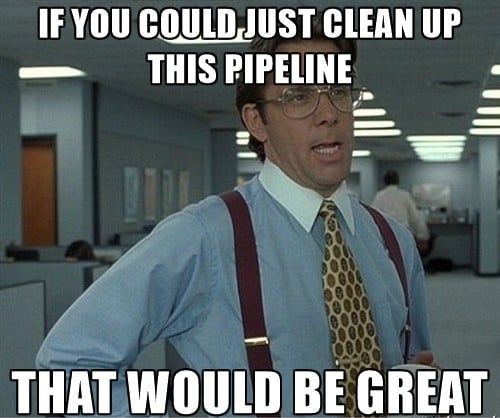Canalización de ventas 101
Lo básico para hacer vibrar su proceso de ventas B2B.

Días largos, noches tardías. Una agenda repleta, un teléfono caliente y una bandeja de entrada repleta. El café es tu mejor amigo y los negocios no paran. Parece la vida de un empresario de éxito, ¿verdad? Y sin embargo, en medio de esa montaña de papeles, notas adhesivas y correos electrónicos, sientes un picor. Se hacen ventas, pero parecen más un accidente que un éxito. This isn’t working.
I used to just let my thoughts and ideas float, not bothering with structure and organisation. To-do lists and diaries were for suckers. As a student that meant missing chapters to study. As an entrepreneur it means missing deals and revenues. And while nobody likes bad grades, missing out on sales is worse. It’s dangerous for the survival of your business. Especially if you’re in the early stages.
What you need is a system. Something to bring order to the chaos that is your sales process. Something to keep track of your leads, so no deals fall through the cracks anymore. What you need, my friend, is a sales pipeline. We’ll show you why you need one, how to set up one up and what you can do to have it run as smoothly as possible.
Why do I need this, exactly? 🤔
If you want to excel at something, you first need to get the basics right. The basics of b2b selling are pretty straightforward. Someone is looking to improve his/her life and you’re trying to help them see why your product or service is the best one for the job. Bastante simple.
But humans are complicated creatures. Decision-making is not a linear process and external factors — like competitors — may come into play. As a sales person it’s your job to guide your prospect through the complexities that come with decision-making, straight to your solution.
A sales pipeline is a snapshot of where leads are in your sales process. It’s a visual, organised way to keep track of your potential buyers as they move through the different stages. Thinking of your sales process as a pipeline forces you to streamline your efforts into a repeatable and measurable process with clearly defined steps. It creates a shared understanding that will make your sales more actionable and scaleable.

The goal is to take your sales lead from stage to stage, all the way up to the definitive yes. If you fail, the deal is lost or can be put in the fridge to retarget later. The thing is that in sales you can’t control results. What you can control, are activities. Only when your whole team has a shared understanding of what your sales process should be, you’ll be able to optimise those activities and, in turn, improve results. In order to improve, you first need to know what your problems are.
Where is it that most deals go bad? What stage is taking the longest? How about stage-over-stage conversion? How many deals do I need to add to my pipeline to reach my goals? The sales pipeline will help you find out where you fail. Next, you’ll be able to turn those failures into best practices.
One step at a time ☝️
Chances are you’re already using the sales pipeline metaphor in approaching potential buyers. The typical stages of a sales pipeline follow the natural flow of a sales process. Of course, no sales pipeline outline fits all. Some stages may be more relevant to your sales process, others will overlap. The selling stages of your SaaS company will be different from those of a realtor. However, conceptually, a sales process goes something like this:
- Dirección
The first time someone appears on your radar. He or she may be interested in your solution and you suspect they might be a good fit. Leads may just come to you, for example because they filled out a form on your website. Or you look for them, in places like conferences, social media or just ‘the Internet’. This is actually a pre-pipeline etapa. Antes de que se conviertan en una oportunidad de venta, debe averiguar si pueden ser un cliente potencial real para su empresa. - Contactado
The first time you reach out and have actual contact. This will likely happen by email or call. Your goal is to verify the lead’s interest in your solution. If yes, you put them in the pipeline. If you find a lead from a positive reaction to a cold email or call, you can immediately put the lead in this stage. - Cualificación
This is where you determine whether the lead is a good fit for your business as a customer. Are they within your target market? Do they have a real need for your solution? Do they have a budget and a clear timeline to buy in? Are you talking to the right people in the company? You’ll have to determine if you think a deal can be closed within the usual length of your sales process or not. This often involves a meeting and/or a series of calls. You’ll look for a match between your solution and your lead’s specific challenges. Don’t lose any time if there’s no match: just close the sales opportunity as lost. - Propuesta formulada
By now, you’ve built enough momentum to make a formal offer. It’s now up to the lead to either buy or refuse. - Ganar/Perder
The moment of truth. Time to get a signature on that bottom line… or not.
A sales pipeline is like an arcade game. As a player you have to get your lead from stage to stage. You only win if you can complete all 5 stages. One mistake on the way and it’s game over for that lead. This is why it’s key to have a proper amount of leads in the front of your pipeline. You’ll want to protect yourself from certain leakage in your pipeline and make sure you win enough deals at the end of the day. This quality of the sales pipeline to actively drive your sales process is one its most important reasons for you to use it.
Great! Where do I start? 🤠
Bien, coge un trozo de papel o un montón de post-its y una pizarra. Escribe tus etapas de izquierda a derecha y asigna cada uno de tus leads actuales a una etapa. También puedes añadir otros datos: tamaño de la operación, fecha de cierre prevista y representante de ventas que trabaja en la operación. A continuación, ajústelo a medida que avanza en el tiempo y los clientes potenciales pasan por su pipeline. Realice un seguimiento de la conversión entre etapas y del tiempo medio necesario para cada etapa.
Ahora, por el bien de los árboles y el tiempo, es posible que desee cambiar el lápiz y el papel por una buena hoja de cálculo de edad. Esto puede ser una gran manera para que usted pueda entrar en los fundamentos de la gestión de la canalización de ventas. Hemos creado una plantilla para que empieces. Cubre todos los aspectos básicos de la gestión del pipeline de ventas. ¡Vuélvete loco!
Tools like Excel or Google Sheets can work fine for you as long as you’re not dealing with, let’s say, more than 10 potential customers at a time. But, as you grow bigger, the risk of losing overview and deals will do too. This is where you may want to consider using a proper CRM. Salesflare was developed to be simpler than pen and paper and more powerful than a spreadsheet.
Let’s get you a head-start 👊
So now you know what a sales pipeline is and why you need one. Time for you to get behind the wheel and start racing. Here’s three tips to make sure you make it off the start grid in pole position.
Crunch the numbers 📈
You don’t want to be driving in the dark. It’s dangerous and you have no idea where you will end up. Your pipeline’s conversion metrics are essential to keep you on the right track and will make your sales efforts scaleable.
En primer lugar, el ciclo de ventas. El ciclo de ventas es el tiempo que tarda un comprador potencial en convertirse en cliente. Dicho de otro modo: ¿cuánto tardan normalmente los clientes potenciales en entrar en su cartera y salir por el otro extremo? Si un cliente potencial tarda más de lo habitual, puede que le interese descartarlo y centrar sus esfuerzos en otros. El mismo principio puede aplicarse a las distintas etapas.

Second, stage-over-stage conversion. Knowing how many deals you close on average will give you an idea of how many leads you need to add to meet your objectives. As said before: you can’t control results, but you can control activities.
Las ventas son un juego de números. Hechos, cifras y ciencia es lo que usted quiere para estar al tanto de su proceso de ventas. Solo cuando todos los vendedores siguen la misma definición se puede confiar en el proceso.
Flush regularly 🌊
Bigger isn’t always better. A pipeline stuffed with leads may seem like a good thing, but as a startup or small business you don’t have infinite resources. You’ll want to be selective in what you spend your time and energy on.

Eliminar clientes potenciales puede parecer contraintuitivo, incluso extraño. Pero es necesario para garantizar un flujo constante de clientes potenciales y efectivo a través de su canal de ventas. Hay algunas cosas que puedes hacer para mantener las tuberías limpias:
- Be picky when it comes to lead qualification. A clean pipeline begins with the quality of the leads you put in in the first place. If you don’t really believe a lead could turn into a sale, it doesn’t belong in your pipeline. You want to focus your efforts on deals you feel confident of closing within a healthy sales cycle.
- Do spring cleaning every one or two weeks. Check up on all the deals in your pipeline and identify the ones that hold up the pack. You don’t have to get rid of them. Instead, put them in an alternative pipeline or in the fridge, to follow up on later.
- Focus on deals you’re confident of closing within a healthy sales cycle. If you’re a Salesflare user you can use the hot-or-not feature to detect hot leads. Sluggish ones will show up in your insights and home screen.
The Power of Automation 🤖
Su canal de ventas necesita un flujo y usted también. Utilice el El poder del hábito para mantenerse al día. La incorporación de nuevas ofertas, la cualificación de clientes potenciales por etapas y la limpieza periódica de la cartera de oportunidades son actividades clave que puede incorporar fácilmente a su rutina diaria. Convertir estas actividades en hábitos garantizará la máxima productividad con el mínimo esfuerzo. Su canal de distribución en piloto automático.

And you don’t have to stop there. Today’s technology makes it possible to run most other, mindless tasks automatically. No more admin work. Read here how Salesflare frees you of manually inputting data and automatically logs customer interactions. Zapier can make your CRM work together with all of your other productivity tools, like Google Sheets, MailChimp, Trello and Slack. You can just focus on the art of managing human relationships and closing sales while your pipeline runs itself.
Un estudio de 2015 de Harvard Business Review descubrió una correlación directa entre la gestión eficaz del proceso de ventas y un fuerte crecimiento de los ingresos. Utilizar una cartera de ventas para gestionar su proceso de ventas es la forma más rápida de cumplir las previsiones, alcanzar las cuotas y ver cómo los representantes de ventas rinden más de lo que imaginaba. No hay trampas, sólo tiene que configurarlo. Puede empezar hoy mismo.
Echa un vistazo a esta nueva, más larga y detallada guía sobre pipelines de ventas si quieres saber más.
We hope you liked this post. If you did, hit ❤ and spread the word! You can follow us @salesflare en Twitter para más información sobre crm, ventas, growth hacking y startups.
- Los 20 mejores libros de ventas que probablemente esté leyendo Elon Musk - 14 de febrero de 2023
- 6 formas infalibles de conseguir para tu startup sus primeros 100 clientes - 6 de diciembre de 2022
- Cómo construir un embudo de ventas que venda - 2 de septiembre de 2021
